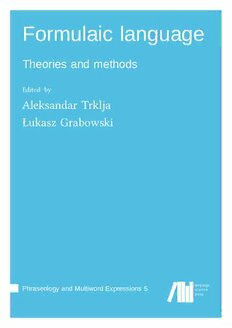Table Of ContentFormulaic language
Theories and methods
Edited by
Aleksandar Trklja
Łukasz Grabowski
language
Phraseology and Multiword Expressions 5
science
press
PhraseologyandMultiwordExpressions
Serieseditors
AgataSavary(UniversityofTours,Blois,France),ManfredSailer(GoetheUniversityFrankfurt
a.M.,Germany),YannickParmentier(UniversityofLorraine,France),VictoriaRosén(Universityof
Bergen,Norway),MikeRosner(UniversityofMalta,Malta).
Inthisseries:
1. ManfredSailer&StellaMarkantonatou(eds.).Multiwordexpressions:Insightsfroma
multilingualperspective.
2. StellaMarkantonatou,CarlosRamisch,AgataSavary&VeronikaVincze(eds.).Multiword
expressionsatlengthandindepth:ExtendedpapersfromtheMWE2017workshop.
3. YannickParmentier&JakubWaszczuk(eds.).Representationandparsingofmultiword
expressions:Currenttrends.
4. SchulteimWalde,Sabine&EvaSmolka(eds.).Theroleofconstituentsinmultiword
expressions:Aninterdisciplinary,crosslingualperspective.
5. Trklja,Aleksandar&ŁukaszGrabowski(eds.).Formulaiclanguage:Theoriesandmethods.
ISSN:26253127
Formulaic language
Theories and methods
Edited by
Aleksandar Trklja
Łukasz Grabowski
language
science
press
AleksandarTrklja&ŁukaszGrabowski(eds.).2021.Formulaiclanguage:
Theoriesandmethods(PhraseologyandMultiwordExpressions5).Berlin:
LanguageSciencePress.
Thistitlecanbedownloadedat:
http://langsci-press.org/catalog/book/304
©2021,theauthors
PublishedundertheCreativeCommonsAttribution4.0Licence(CCBY4.0):
http://creativecommons.org/licenses/by/4.0/
ISBN:978-3-96110-310-2(Digital)
978-3-98554-006-8(Hardcover)
ISSN:2625-3127
DOI:10.5281/zenodo.4727623
Sourcecodeavailablefromwww.github.com/langsci/304
Collaborativereading:paperhive.org/documents/remote?type=langsci&id=304
Coverandconceptofdesign:UlrikeHarbort
Typesetting:SebastianNordhoff,FelixKopecky
Proofreading:AlexandruCraevschi,AmirGhorbanpour,AniefonDaniel,
BojanaBašaragin,BrettReynolds,DylanTemel,ElenLeFoll,HellaOlbertz,
IkmiNurOktavianti,JeroenvandeWeijer,LachlanMackenzie,MartenStelling,
MatthewWindsor,JeanNitzke,SarahDaniel,StefanHartmann,Tihomir
Rangelov,ValeriaQuochi
Fonts:Libertinus,Arimo,DejaVuSansMono
Typesettingsoftware:XƎLATEX
LanguageSciencePress
xHain
GrünbergerStr.16
10243Berlin,Germany
langsci-press.org
StorageandcataloguingdonebyFUBerlin
Contents
Introduction
AleksandarTrklja&ŁukaszGrabowski iii
I Newtheoreticalandmethodologicalinsightsintoformulaic
language
1 Predictabilityandprefabstatus:Thecaseofadjective+noun
sequencesinEnglish
JoanBybee&RicardoNapoleãodeSouza 3
2 Cascadingcollocations:Collocadesascorrelatesofformulaic
language
RichardForsyth 31
3 Exploringthevalencyofcollocationalchains
PiotrPęzik 53
II Formulaiclanguageinlanguagelearningcontexts
4 Pathstoformulaicity:HowdoL2speakersinternalisenewformulaic
material?
StephenF.Cutler 81
5 FormulaicsequenceswithideationalfunctionsinL1studentand
expertacademicwritinginEnglish
YingWang 113
III Formulaiclanguageindiscoursestudiesandtranslation
6 Readingdiscoursesthroughtheirphraseology:ThecaseofBrexit
AndreasBuerki 141
AleksandarTrklja&ŁukaszGrabowski
7 Grammarpatternsasanexploratorytoolforstudyingformulaicityin
English-to-Polishtranslation:Acorpus-basedstudy
ŁukaszGrabowski&NicholasGroom 171
8 God,theDevil,andChrist:AcorpusstudyofRussiansyntactic
idiomsandtheirEnglishandFinnishtranslationcorrespondences
MikhailMikhailov 191
Index 224
ii
Introduction
Aleksandar Trklja
UniversitätInnsbruck
Łukasz Grabowski
UniversityofOpole
Thenotionofformulaicityhasreceivedincreasingattentionindisciplinesand
areasasdiverseaslinguistics,literarystudies,arttheoryandarthistory.Inrecent
years, linguistic studies of formulaicity have been flourishing (e.g. Wray 2002;
2008; 2009; Schmitt & Carter 2004; Wood 2010b,a; 2015; Kecskes 2016; Myles &
Cordier2017;Piirainenetal.2020),andtheverynotionofformulaicityhasbeen
approachedfromvariousmethodologicalandtheoreticalperspectivesandwith
variouspurposesinmind,beitdescriptive,exploratoryorapplied.
The object of investigation in linguistic studies are multiword expressions
(MWE) but individual approaches and models differ in how MWE are defined
andidentifiedinlanguage.Forthesereasons,itwouldbewrongtoclaimthatall
linguisticstudiesofformulaicityconstituteauniformfieldofresearch.Thereis
nosuchathingas’formulaicitylinguistics’.Linguisticformulaicityhasbecome
a superordinate term for the view that a large proportion of natural language
consists of repetitive lexical units. This makes MWE somehow special with re-
specttoalternativelinguisticunitsofanalysisthathavetheoreticalfoundations
informalsyntactic,semanticorlexicalstructures.Suchstructurescanbeandare
oftenincludedinthestudyoflinguisticformulaicitybuttheydonotprovidethe
minimumnecessaryconditionsagainstwhichMWEaresetaslinguisticunits.In
fact, there are authors who proposed new approaches or models that deny the
existence of such structures. The minimum assumption shared by all studies of
linguisticformulaicityisthataMWEisconsideredaunitbecauseitisalinguis-
tic expression that has been repeatedly reused. The very fact that a linguistic
expressionisre-usedacrossdifferentsituationsandbydifferentlanguageusers
constitutesagoodgroundtotreatitasaunitofanalysis.Itisthereforenowonder
thatthemainfocusinthestudyoflinguisticformulaicityisontheinvestigation
Aleksandar Trklja & Łukasz Grabowski. 2021. Introduction. In Aleksandar
Trklja&ŁukaszGrabowski(eds.),Formulaiclanguage:Theoriesandmethods,
iii–viii.Berlin:LanguageSciencePress.DOI:10.5281/zenodo.4727659
AleksandarTrklja&ŁukaszGrabowski
of the effect repetition has on various language issues such as idiomaticity, lan-
guage acquisition, formation of social discourses, translation-related issues etc.
As one can see, the novelty of these studies does not lie in the introduction of
newissuestheyaddressbutratherinanewtreatmentofestablishedissues.
Linguists of various schools have studied linguistic formulaicity using differ-
ent approaches and research perspectives, and with different purposes in mind.
In an attempt to provide a useful generalization and conceptual clarification,
Gałkowski(2006:163–164)arguesthatitispossibletodistinguishbetweenthree
major approaches to linguistic formulaicity, namely a linguistic, psycholinguis-
ticandsociolinguisticone.Thefocusofthepurelylinguisticapproachisonthe
investigationofformulaicityintermsoflexicalandgrammaticalcategoriesiden-
tifiedprimarilyusingformalgrammaticalorfunctionallexicalcriteria.Thepsy-
cholinguistic approach is primarily concerned with the study of how linguistic
data is stored, processed as well as retrieved from the mental lexicon. Finally,
thesociolinguisticapproachexploressituationalandculturalaspectstiedtothe
use of formulaic language (Gałkowski, ibid.). In reality, most studies combine
theseapproachesasillustratedinSchmitt&Carter(2004);Wood(2010b,a;2015);
Wray (2002) or Underwood et al. (2004); Piirainen et al. (2020), among others.
Also,therehasbeenaplethoraofresearchconductedinrecentyearsbyspecial-
istsincorpusandcomputationallinguistics,whostudyformulaiclanguagewith
primarily applied purposes in mind, such as development of natural language
processing tools (NLP) or machine translation tools, fine-tuning textual classi-
fication methods etc. (cf. Forsyth & Grabowski 2015; Pęzik 2018). Given such a
proliferation of research perspectives, it is no surprise that formulaic language
hasbeendefined,labelledandoperationalizedinmanydifferentways(cf.Wray
& Perkins 2000; Wray 2002; 2009), and each approach brings new insights into
this interesting, yet at the same time, not fully and comprehensively explored
phenomenon.Thisobservationprovidedthemainrationaleforthepresentvol-
ume.Weinvitedspecialiststhatcoverthewholespectrumofrelevantissuesand
thusshowcasetheirstate-of-the-artresearch.
Thus,wepresentaselectionofstudiesintoformulaiclanguagearrangedinto
complementarysections.Thefirstsectionwiththreechapterspresentsnewtheo-
reticalandmethodologicalinsightsaswellastheirpracticalapplicationinthede-
velopmentofcustom-designedsoftwaretoolsforidentificationandexploration
of formulaic language in texts. The second section with two chapters presents
examples of innovative research into formulaic language in language learning
contexts. Finally, the third section with three chapters showcases research on
formulaic language conducted primarily from corpus linguistic, discourse stud-
iesandtranslationstudiesperspectives.
iv
Introduction
The first chapter by Joan Bybee and Ricardo Napoleão de Souza focuses on
the relation between frequency effects typical of linguistic prefabrication and
phonetic effects. By exploring a sample of adjective-noun sequences extracted
from a conversational corpus, Bybee and de Souza show that certain phonetic
effects,suchasvowelduration,correspondtoconventionalizedstructuresfound
inprefabricatedexpressions.Theyalsoarguethatphoneticeffectsarepromising
in view of future studies focusing on the notion of conventionality of prefabri-
catedexpressions.Theauthorsdemonstratethatprefabricatedexpressionscon-
stitutetheconventionalmeansofreferringtotheseentitiesorconceptsofsome
culturalimportancedespitebeingsemanticallycompositional.Inaddition,they
showthatprefabsformclustersofsemanticallyrelatedwordsequencesandthat
theycancontributetocreativityinlanguageuse.
RichardForsythlooksintoformulaiclanguagefromacorpus-drivenperspec-
tiveandproposesasetofcomputationalprocedurestoquantifythedegreeoffor-
mulaic language in individual texts and language corpora. Forsyth implements
hisapproachintoacustom-designedfreelyavailablesoftwarewritteninPython
andshows-usinganadditionalcriterionofcoverage-hown-gramsofvarious
lengthsemergefromthedataandfacilitatedeterminationofthedegreetowhich
textsarepermeatedwithrecurrentsequencesofwords.
The chapter by Piotr Pęzik focuses on the identification of prefabricated ex-
pressions in dependency-annotated corpora. More precisely, he investigates re-
strictionsonthevalencyofbinarycollocationsandtheirtendencytoberegularly
subsumedbylargercollocationalchains.SpecificexamplesfromPolishandEn-
glish are followed by a presentation of Treelets software, where the Author’s
approachhasbeenimplemented,whichillustratesinpracticaltermshowrecur-
rentmulti-worditemsmaybesystematicallyexploredusingdependency-based
methods.
The second section opens with a contribution by Stephen Cutler, who deals
withanimportantproblemofhownewformulaiclanguageisacquiredandstored
byL2learnersofEnglish.Inthesestudies,twodifferentlearningpathsarecon-
trasted:fusion(operationalizedthroughafocusonthesequence’selementsand
structure)versusholisticacquisition(operationalizedthroughafocusonthespo-
ken sound form of the sequence as a whole). Cutler argues that the findings
providefurthersupporttotheclaimthatregularretrievalandsimplecorrective
feedbackhelpconsolidaterecallofthesequenceslearntbyL2learners.
YingWangundertakesasuccessfulattemptatacomparisonofideationalfunc-
tionsofformulaiclanguageinnativestudentandexpertacademicwriting.The
chapter presents unique features of formulaic sequences identified in each text
varietyandshowsthatnativestudentwritingismorecharacteristicofeveryday
v
AleksandarTrklja&ŁukaszGrabowski
andhighlyidiomaticformulaicsequences,amongothers,whileexpertacademic
writing abounds in formulaic language associated with research and scientific
argumentation.Inconclusion,YingWangpresentsaninformativediscussionon
howtheresearchfindingstranslateintoformalinstruction.
The last section of the volume starts with a chapter by Andreas Buerki, who
showshowchangesinsocialdiscoursearereflectedinphraseology.Takingthe
2016 referendum on the United Kingdom’s membership in the European Union
asreflectedinalarge,tailor-madecorpusofmediatexts,Buerkiidentifiesvarious
discursivestrategiesreflectedinrecurrentphraseologiesandcomparestheiruse
across time and specific topics. The results obtained in the study demonstrate
how phraseological units reflect specific ideological positions. In addition, the
presentdataindicatesthatformulaicityplaysanimportantroleintheBrexitdis-
course because it is more formulaic than the comparable discourse. Finally, the
chaptercastsnewmethodologicalinsightsintohowphraseology,andformulaic-
ityingeneral,canbeusedindiscourseanalyticalresearch.
Łukasz Grabowski and Nicholas Groom undertake an attempt at employing
theconceptofgrammarpatternsindescriptiveresearchonformulaiclanguage
inEnglish-to-Polishtranslation.TheiraimistoverifywhetherthePolishequiv-
alentsarerealizedwiththesamelevelofregularity.Thedetailedfindingsshow
that grammar patterns can be useful as a unit of analysis and a starting point
forexplorationofformulaicityintranslation,andthattheymaycastmorelight
ontosomemoregeneraldifferencesbetweensemanticsandpragmaticsinsource
textsandtranslations.
Finally, the last chapter in the volume, by Mikhail Mikhailov, takes under
scrutiny the concept of syntactic idioms and explores through a corpus linguis-
tic analysis the structure, meaning and use of the Russian construction N-s-N
and its English and Finnish matches. These counterparts are identified in par-
allel corpora. Mikhailov argues that the Construction Grammar approach used
inhisstudyhelpsmakesyntacticidiomsmoreexplicitfordescriptivepurposes,
alsowhenexploredwiththeuseofparallelandcomparablecorpora.
Webelievethatsuchaselectionoforiginalstudiescollectedinthisbookwill
providemoreinsightsintoafascinatingphenomenonofformulaicityinlanguage
explored from both a systemic and textual angle. We sincerely hope that the
volumewillthereforecomeinusefulforanyoneinterestedinformulaiclanguage,
frombothatheoreticalandpracticalperspective.
Obviously enough, this volume would not have been possible without many
people involved in its preparation, compilation and production. First of all, we
wouldliketothanktheAuthorsofthechaptersforacceptingourinvitationand
for further smooth collaboration through the entire production process, from
vi

